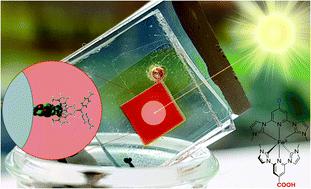当前位置:
X-MOL 学术
›
Chem. Sci.
›
论文详情
Our official English website, www.x-mol.net, welcomes your feedback! (Note: you will need to create a separate account there.)
Dye-sensitized solar cells based on Fe N-heterocyclic carbene photosensitizers with improved rod-like push-pull functionality
Chemical Science ( IF 8.4 ) Pub Date : 2021-11-11 , DOI: 10.1039/d1sc02963k Linnea Lindh 1, 2 , Olga Gordivska 3 , Samuel Persson 3 , Hannes Michaels 4, 5 , Hao Fan 3 , Pavel Chábera 1 , Nils W Rosemann 1, 3 , Arvind Kumar Gupta 3 , Iacopo Benesperi 3, 5 , Jens Uhlig 1 , Om Prakash 3 , Esmaeil Sheibani 3 , Kasper S Kjaer 1 , Gerrit Boschloo 4 , Arkady Yartsev 1 , Marina Freitag 4, 5 , Reiner Lomoth 4 , Petter Persson 2 , Kenneth Wärnmark 3
Chemical Science ( IF 8.4 ) Pub Date : 2021-11-11 , DOI: 10.1039/d1sc02963k Linnea Lindh 1, 2 , Olga Gordivska 3 , Samuel Persson 3 , Hannes Michaels 4, 5 , Hao Fan 3 , Pavel Chábera 1 , Nils W Rosemann 1, 3 , Arvind Kumar Gupta 3 , Iacopo Benesperi 3, 5 , Jens Uhlig 1 , Om Prakash 3 , Esmaeil Sheibani 3 , Kasper S Kjaer 1 , Gerrit Boschloo 4 , Arkady Yartsev 1 , Marina Freitag 4, 5 , Reiner Lomoth 4 , Petter Persson 2 , Kenneth Wärnmark 3
Affiliation

|
A new generation of octahedral iron(II)–N-heterocyclic carbene (NHC) complexes, employing different tridentate C^N^C ligands, has been designed and synthesized as earth-abundant photosensitizers for dye sensitized solar cells (DSSCs) and related solar energy conversion applications. This work introduces a linearly aligned push–pull design principle that reaches from the ligand having nitrogen-based electron donors, over the Fe(II) centre, to the ligand having an electron withdrawing carboxylic acid anchor group. A combination of spectroscopy, electrochemistry, and quantum chemical calculations demonstrate the improved molecular excited state properties in terms of a broader absorption spectrum compared to the reference complex, as well as directional charge-transfer displacement of the lowest excited state towards the semiconductor substrate in accordance with the push–pull design. Prototype DSSCs based on one of the new Fe NHC photosensitizers demonstrate a power conversion efficiency exceeding 1% already for a basic DSSC set-up using only the I−/I3− redox mediator and standard operating conditions, outcompeting the corresponding DSSC based on the homoleptic reference complex. Transient photovoltage measurements confirmed that adding the co-sensitizer chenodeoxycholic acid helped in improving the efficiency by increasing the electron lifetime in TiO2. Time-resolved spectroscopy revealed spectral signatures for successful ultrafast (<100 fs) interfacial electron injection from the heteroleptic dyes to TiO2. However, an ultrafast recombination process results in undesirable fast charge recombination from TiO2 back to the oxidized dye, leaving only 5–10% of the initially excited dyes available to contribute to a current in the DSSC. On slower timescales, time-resolved spectroscopy also found that the recombination dynamics (longer than 40 μs) were significantly slower than the regeneration of the oxidized dye by the redox mediator (6–8 μs). Therefore it is the ultrafast recombination down to fs-timescales, between the oxidized dye and the injected electron, that remains as one of the main bottlenecks to be targeted for achieving further improved solar energy conversion efficiencies in future work.
中文翻译:

基于 Fe N-杂环卡宾光敏剂的染料敏化太阳能电池具有改进的棒状推挽功能
新一代八面体铁(II)-N-杂环卡宾(NHC)配合物,采用不同的三齿C^N^C配体,被设计并合成为染料敏化太阳能电池(DSSCs)和相关太阳能电池的地球丰富光敏剂。能量转换应用。这项工作介绍了一种线性排列的推挽设计原理,该原理从具有氮基电子供体的配体开始,在 Fe( II)中心,配体具有吸电子羧酸锚定基团。光谱学、电化学和量子化学计算的结合证明了分子激发态特性的改进,与参考复合物相比,吸收光谱更宽,以及最低激发态向半导体衬底的定向电荷转移位移。采用推拉式设计。基于一种新型 Fe NHC 光敏剂的原型 DSSC 已经证明,对于仅使用 I - /I 3 -的基本 DSSC 设置,功率转换效率已经超过 1%氧化还原介质和标准操作条件,胜过基于同配参考复合物的相应 DSSC。瞬态光电压测量证实,添加共敏剂鹅去氧胆酸有助于通过增加 TiO 2中的电子寿命来提高效率。时间分辨光谱揭示了从杂配染料到 TiO 2的成功超快 (<100 fs) 界面电子注入的光谱特征。然而,超快复合过程导致来自 TiO 2的不希望有的快速电荷复合回到氧化染料,仅留下 5-10% 的初始激发染料可用于为 DSSC 中的电流做出贡献。在较慢的时间尺度上,时间分辨光谱学还发现重组动力学(长于 40 μs)明显慢于氧化还原介质对氧化染料的再生(6-8 μs)。因此,氧化染料和注入电子之间的超快复合到飞秒时间尺度仍然是未来工作中进一步提高太阳能转换效率的主要瓶颈之一。
更新日期:2021-12-01
中文翻译:

基于 Fe N-杂环卡宾光敏剂的染料敏化太阳能电池具有改进的棒状推挽功能
新一代八面体铁(II)-N-杂环卡宾(NHC)配合物,采用不同的三齿C^N^C配体,被设计并合成为染料敏化太阳能电池(DSSCs)和相关太阳能电池的地球丰富光敏剂。能量转换应用。这项工作介绍了一种线性排列的推挽设计原理,该原理从具有氮基电子供体的配体开始,在 Fe( II)中心,配体具有吸电子羧酸锚定基团。光谱学、电化学和量子化学计算的结合证明了分子激发态特性的改进,与参考复合物相比,吸收光谱更宽,以及最低激发态向半导体衬底的定向电荷转移位移。采用推拉式设计。基于一种新型 Fe NHC 光敏剂的原型 DSSC 已经证明,对于仅使用 I - /I 3 -的基本 DSSC 设置,功率转换效率已经超过 1%氧化还原介质和标准操作条件,胜过基于同配参考复合物的相应 DSSC。瞬态光电压测量证实,添加共敏剂鹅去氧胆酸有助于通过增加 TiO 2中的电子寿命来提高效率。时间分辨光谱揭示了从杂配染料到 TiO 2的成功超快 (<100 fs) 界面电子注入的光谱特征。然而,超快复合过程导致来自 TiO 2的不希望有的快速电荷复合回到氧化染料,仅留下 5-10% 的初始激发染料可用于为 DSSC 中的电流做出贡献。在较慢的时间尺度上,时间分辨光谱学还发现重组动力学(长于 40 μs)明显慢于氧化还原介质对氧化染料的再生(6-8 μs)。因此,氧化染料和注入电子之间的超快复合到飞秒时间尺度仍然是未来工作中进一步提高太阳能转换效率的主要瓶颈之一。



























 京公网安备 11010802027423号
京公网安备 11010802027423号